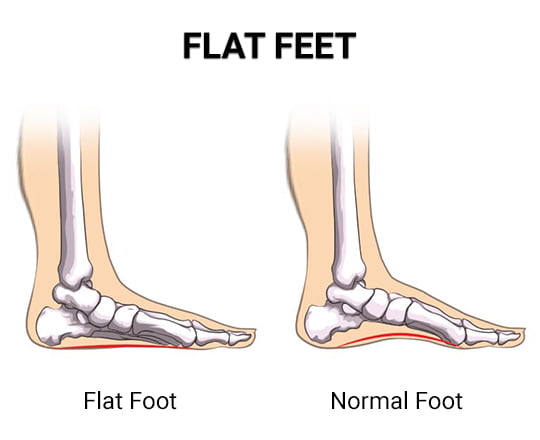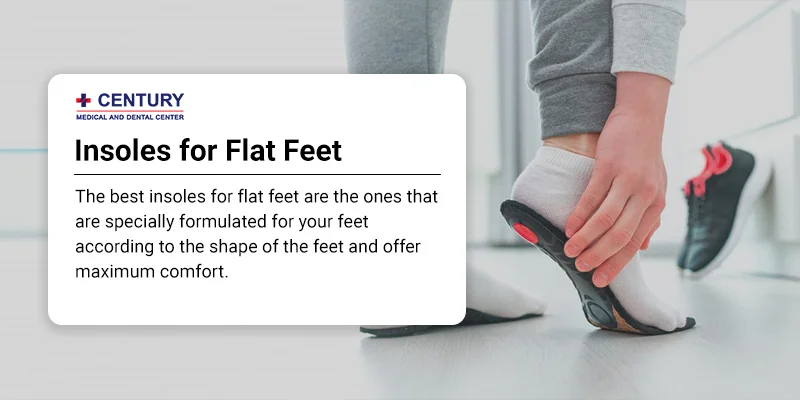Do not let flat feet or fallen arches keep you from participating in a full life. Get the best insoles for flat feet that offer firm support and create the arch when you don’t have one to move around freely. Consult experienced and board-certified podiatrists at the Century Medical and Dental Center to have your feet and ankles carefully examined and to figure out what is affecting your movement. The top-rated doctors recommend the best ways to relieve pain and inflammation caused by flat feet and help in finding the best arch support insoles for your footwear for lasting comfort.

Foot arches help you walk without any pain or discomfort by allowing the middle part of your foot to flex like a blow. They add shock absorption and flexibility to your gait, enhance posture and improve your balance when you stand or walk.
Flatfooted people, it seems, do not have any arches, but they are there, and supporting them the right way is crucial to prevent foot pain and injury. Figuring out exactly how much support your flat foot requires can be challenging, and you end up trying out several remedies before you can find the best way out.
Quality insoles offer a solution to these problems. They reduce the risk of developing painful conditions in the ankles, knees, hips, and back. With their firm arch support, insoles promote better biometrics while standing, walking, or running. They act as a cushion and absorb the shock.
Flat feet is a condition in which the entire bottom of your foot, the sole touches the ground when you are standing. They may lead to problems in your ankles and knees, as this condition can alter the alignment of your legs.
Also known as fallen arches, the flat foot can be painful. Most people with flatfeet have no signs or symptoms, but others experience foot pain, especially in the heel or arch area. Sometimes this pain worsens with activity, and swelling along the inside of the ankle can also occur.
Some common causes of flat feet include:
If you are not sure it is flat feet or something else bothering you and causing pain, consult your primary care doctor to learn about it. Constant pain in the foot not only affects your quality of life but can also disturb the way you walk.

While many people believe them to be the same thing, they are not. Flat feet are conditions that exist from birth. People are born with flat feet, but fallen arches develop in adulthood due to various reasons.
Fallen arches develop as a result of:
An injury – Dislocating bones or tearing tendons can result in fallen arches. If the tendons that attach leg muscles to the foot to create the curve, are injured or loosen, arches can fall.
Arthritis or similar condition – Rheumatoid arthritis is the inflammation of the joints, and it can be painful when it occurs in the feet, causing constant and intense pain. When the ankle and feet joints fail to work right, it can loosen the arch muscles, leading to fallen arches.
Weight fluctuation or pregnancy – Extra body weight can increase the pressure on the foot tendons. The weight gain and hormonal changes during pregnancy can also change the arch condition in women and lead to fallen arches, particularly during their first pregnancy.
Fallen arches can cause symptoms, such as easily tiring feet, foot pain, back pain, and swollen ankles. They can also aggravate existing knee and hip pain, affecting your walk and balance. As they make your toes work harder when you walk, striving for balance, fallen arches can also lead to corns and blisters on your feet.
Whether you suffer from flat feet caused by genetics or fallen arches that result from some injury or other conditions, you may end up with a lot of complications.
Common experienced injuries and problems resulting from flat feel include:
Abnormal stress on the feet, ankles, and legs can affect the way you walk. These injuries or problems can be painful and affect how you balance yourself or walk. Fortunately, these problems can be effectively addressed with the right insoles, and you can seek relief without suffering any more pain.
Strengthening and stretching exercises for the feet, calves, and ankles can help to alleviate the pain from low arch or flat feet. Adding arch-supporting insoles to your footwear can help in long-term pain relief.
Podiatrists and physical therapists recommend the following exercises to strengthen your feet and enhance arch support.
A weak foot core or intrinsic muscle of the foot can lead to instability and injury. There are 11 small intrinsic muscles located in the foot that generate its motion. They play a crucial role in stabilizing the foot during strike and push-off. They absorb the load and store energy mid-stance and also support the arch.
Strengthening these intrinsic muscles will help them provide better support to the arch in case of flat feet. Quick foot core exercises include:
Foot doming – Place your foot in a neutral position, flat on the floor. Shorten the foot by contracting the foot core muscles to arch the soles of the foot. Make sure to keep the toes flat on the ground. Start sitting down, and as you progress, try standing, then standing on one foot, and then hopping.
Heel raises – stand in the middle of the room and press all of your toes firmly into the floor. Lift both your heels up, so that all your weight is transferred to the toes. Hold this stance for two seconds and repeat. Try at least two sets of 15 repetitions.
Tight calves and Achilles’s tendons pull up on the ankle that forces the foot to pronate or roll inwards. It, in turn, causes the arch to collapse. Stretching the calves and heel cords can help to prevent fallen arches.
Exercises to strengthen and stretch calves and ankles include:
Achille’s tendon stretch – Put the front of your foot on a step while the heels are off the step. Relax the calf muscles, and slowly let your heels down over the edge of the step for 10 to 15 seconds. The stretch should be felt along the Achilles tendon.
Calf muscle stretch – Stand with one foot about a foot in front of the other. Point the toes of the back foot towards the heel of the front and lean towards a wall. Keep the back leg straight and bend your front one, keeping both heels planted on the floor. Hold for 10 to 15 seconds. Repeat the exercise on the other side.
Stretching and strengthening the arch and calves help alleviate the pain associated with flat feet. But it is not a long-term solution. You must seek insoles to support your arches for walking, running, and standing comfortably without putting pressure on your feet.
Fallen arches are something that develops with time or injury. There are ways you can treat them and find short, as well as long-term relief.
Foot pain caused by fallen arches can be treated with:
If you are unable to find relief, there are other options too. They include:
Consulting your doctor is essential to determine the best course of action. The medical expert will examine your feet, diagnose what you are suffering from and recommend the arch support insoles that provide adequate support for your feet.
People with flat feet need arch support that provides relief from the pressure on the arch and reduces pain if the feet roll too far inward. However, selecting the right insoles is very important that are flexible, fit in, and offer the right level of support to provide the desired comfort.
Finding the best insoles is all about identifying the type of flat foot you have, rigid flat feet or flexible flat feet. Making the distinction between rigid and flexible flat feet will ensure you get the right product that helps to overcome the challenges you are facing and ease your movement.
Rigid flat feet – If you put your foot over the opposite knee and your foot still looks flat, you have rigid flat feet. They are flat when you stand on them and flat when your feet are unweight. People with rigid flat feet usually go for arch supports for flat feet with a low arch height.
Flexible flat feet – If you put your feet over the opposite knee and your arch appears, it indicates flexible flat feet. They are flat when you are standing, but they show a curve when they are unweight. People with flexible flat feet usually prefer arch support for flat feet with a medium arch height.
It is necessary to know that flat feet cannot be turned into feet with high arches, and there is no need to do so. Starting with a low or medium arch insole, based on the type of flat foot you have is the best option. A high or extra high arch will be uncomfortable, and you will get the feel of having a golf ball in your shoe.
The best insoles for flat feet are the ones that are specially formulated for your feet according to the shape of the feet and offer maximum comfort. These insoles are custom designed for your feet considering how your bones, muscles, joints, and ligaments move together. They are created with the right features to correct your problem, ease your ache and achieve your goals.
They offer:
Low supportive arch – you need a low arch that offers strong support. A firm arch that is too high will lead to pain. A soft arch compressed by your foot will also not last long. Insoles are not a one-size-fits-all product. You must buy insoles after consulting your doctor and considering the unique characteristics of your feet.
Heel stabilization – deep heel cups focus on the fatty pads underneath your heel bone. It helps to prevent overpronation and increase shock absorption, and you can walk and balance yourself better with the perfect support.
Wearing appropriate footwear can make a big difference if you are flat-footed. Shoes that do not offer adequate support can leave your feet tired, sore, and aching at the end of the day. Determining the kind of flat foot you have and going for the best insoles can add maximum support to your footwear and help your low arches, offering the much-needed respite from pain.
The best podiatrists at the Century Medical and Dental Center can make the difference between ongoing pain and comfort and recovery. The expert foot and ankle doctors examine your feet and ankles to identify the source of your pain and help you find custom insoles to solve all your problems. You can look forward to alleviating pain caused by fallen arches, flat feet, or other foot disorders by making your footwear more comfortable and choosing the best insoles.
Century Medical and Dental Center is an accredited healthcare facility in NY that operates in accordance with Article 28, a public health law. This law regulates and recognizes accreditation for public healthcare facilities, ensuring they are licensed and operated correctly. By undergoing the Article 28 process and achieving accreditation, Century Medical and Dental Center demonstrates its commitment to meeting the highest standards of care.
As a multidisciplinary medical center, we have highly qualified doctors, nurses, and support staff who are working hard to provide the best medical care to patients in Midtown Manhattan, NY, Downtown Brooklyn, NY, including Brooklyn Heights, Dumbo, Prospect Heights, Park Slope, Clinton Hill, Boerum Hill, Red Hook, Harlem, Gravesneck, Flatbush, and Bedford-Stuyvesant.